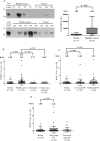Systematic verification of bladder cancer-associated tissue protein biomarker candidates in clinical urine specimens
- PMID: 30112103
- PMCID: PMC6089400
- DOI: 10.18632/oncotarget.24578
Systematic verification of bladder cancer-associated tissue protein biomarker candidates in clinical urine specimens
Abstract
Bladder cancer biomarkers currently approved by the Food and Drug Administration are insufficiently reliable for use in non-invasive clinical diagnosis. Verification/validation of numerous biomarker candidates for BC detection is a crucial bottleneck for novel biomarker development. A multiplexed liquid chromatography multiple-reaction-monitoring mass spectrometry assay of 122 proteins, including 118 up-regulated tissue proteins, two known bladder cancer biomarkers and two housekeeping gene products, was successfully established for protein quantification in clinical urine specimens. Quantification of 122 proteins was performed on a large cohort of urine specimens representing a variety of conditions, including 142 hernia, 126 bladder cancer, 67 hematuria, and 59 urinary tract infection samples. ANXA3 (annexin A3) and HSPE1 (heat shock protein family E member 1), which showed the highest detection frequency in bladder cancer samples, were selected for further validation. Western blotting showed that urinary ANXA3 and HSPE1 protein levels were higher in bladder cancer samples than in hernia samples, and enzyme-linked immunosorbent assays confirmed a higher urinary concentration of HSPE1 in bladder cancer than in hernia, hematuria and urinary tract infection. Immunohistochemical analyses showed significantly elevated levels of HSPE1 in tumor cells compared with non-cancerous bladder epithelial cells, suggesting that HSPE1 could be a useful tumor tissue marker for the specific detection of bladder cancer. Collectively, our findings provide valuable information for future validation of potential biomarkers for bladder cancer diagnosis.
Keywords: MRM; biomarker verification; bladder cancer; protein quantification; targeted proteomics.
Conflict of interest statement
CONFLICTS OF INTEREST none.
Figures



Similar articles
-
Multiplexed quantification of 63 proteins in human urine by multiple reaction monitoring-based mass spectrometry for discovery of potential bladder cancer biomarkers.J Proteomics. 2012 Jun 27;75(12):3529-45. doi: 10.1016/j.jprot.2011.12.031. Epub 2012 Jan 3. J Proteomics. 2012. PMID: 22236518
-
Comparative and targeted proteomic analyses of urinary microparticles from bladder cancer and hernia patients.J Proteome Res. 2012 Dec 7;11(12):5611-29. doi: 10.1021/pr3008732. Epub 2012 Oct 31. J Proteome Res. 2012. PMID: 23082778
-
Comparative Tissue Proteomics of Microdissected Specimens Reveals Novel Candidate Biomarkers of Bladder Cancer.Mol Cell Proteomics. 2015 Sep;14(9):2466-78. doi: 10.1074/mcp.M115.051524. Epub 2015 Jun 16. Mol Cell Proteomics. 2015. PMID: 26081836 Free PMC article.
-
MRM for the verification of cancer biomarker proteins: recent applications to human plasma and serum.Expert Rev Proteomics. 2014 Apr;11(2):137-48. doi: 10.1586/14789450.2014.877346. Epub 2014 Jan 29. Expert Rev Proteomics. 2014. PMID: 24476379 Review.
-
SRM/MRM targeted proteomics as a tool for biomarker validation and absolute quantification in human urine.Expert Rev Mol Diagn. 2015;15(11):1441-54. doi: 10.1586/14737159.2015.1093937. Epub 2015 Oct 15. Expert Rev Mol Diagn. 2015. PMID: 26472065 Review.
Cited by
-
Identification and Validation of a Prognostic 5-Protein Signature for Biochemical Recurrence Following Radical Prostatectomy for Prostate Cancer.Front Surg. 2021 May 31;8:665115. doi: 10.3389/fsurg.2021.665115. eCollection 2021. Front Surg. 2021. PMID: 34136527 Free PMC article.
-
HSPE1 Inhibits Bladder Cancer Ferroptosis via a Glutathione-Dependent Mechanism by Suppressing GPX4.Am J Mens Health. 2024 Nov-Dec;18(6):15579883241306904. doi: 10.1177/15579883241306904. Am J Mens Health. 2024. PMID: 39688244 Free PMC article.
-
Cancer-associated fibroblasts contribute to cisplatin resistance by modulating ANXA3 in lung cancer cells.Cancer Sci. 2019 May;110(5):1609-1620. doi: 10.1111/cas.13998. Epub 2019 Apr 9. Cancer Sci. 2019. PMID: 30868675 Free PMC article.
-
Unleashing the power of urine‑based biomarkers in diagnosis, prognosis and monitoring of bladder cancer (Review).Int J Oncol. 2025 Mar;66(3):18. doi: 10.3892/ijo.2025.5724. Epub 2025 Feb 7. Int J Oncol. 2025. PMID: 39917986 Free PMC article. Review.
-
Comparative proteomics analysis in different stages of urothelial bladder cancer for identification of potential biomarkers: highlighted role for antioxidant activity.Clin Proteomics. 2023 Jul 27;20(1):28. doi: 10.1186/s12014-023-09419-8. Clin Proteomics. 2023. PMID: 37501157 Free PMC article.
References
-
- Torre LA, Bray F, Siegel RL, Ferlay J, Lortet-Tieulent J, Jemal A. Global cancer statistics, 2012. CA Cancer J Clin. 2015;65:87–108. - PubMed
-
- Siegel R, Ma J, Zou Z, Jemal A. Cancer statistics, 2014. CA Cancer J Clin. 2014;64:9–29. - PubMed
-
- Kaufman DS, Shipley WU, Feldman AS. Bladder cancer. Lancet. 2009;374:239–49. - PubMed
-
- Saad A, Hanbury DC, McNicholas TA, Boustead GB, Morgan S, Woodman AC. A study comparing various noninvasive methods of detecting bladder cancer in urine. BJU Int. 2002;89:369–73. - PubMed
-
- Jordan AM, Weingarten J, Murphy WM. Transitional cell neoplasms of the urinary bladder. Can biologic potential be predicted from histologic grading? Cancer. 1987;60:2766–74. - PubMed
LinkOut - more resources
Full Text Sources
Other Literature Sources
Research Materials
Miscellaneous

